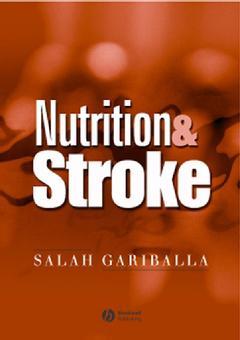Description
Nutrition and Stroke
Prevention and Treatment
Author: Gariballa Salah
Language: English
Subject for Nutrition and Stroke:
194 p. · 17.3x24.4 cm · Paperback
Description
/li>Contents
/li>Biography
/li>
The book is divided into three major sections. Section I covers nutrition and ageing and includes chapters on the challenge of stroke, ageing changes and nutrition, macro- and micronutrient intake in elderly people and the diagnosis of protein-energy undernutrition. Section II deals with nutritional factors and the risk of stroke, and includes details of the role of dietary and nutritional factors in stroke prevention, antioxidants and risk from ischaemic stroke, homocysteine and endothelial dysfunction. The final section of the book covers nutrition factors following stroke, including cerebral ischaemia, protein-energy undernutrition and the nutritional status and support of stroke and special stroke patients. A final chapter looks at probable future directions, including important recommendations.
Nutrition and stroke is essential reading for nutritionists, dietitians and many other groups of health professionals, including general practitioners, gerontologists, occupational therapists and nursing staff. Personnel in pharmaceutical and food companies involved in the formulation of dietary supplements and nutraceuticals will find much of interest within the book?s covers. Those dealing with the prevention and treatment of stroke around the world should read this book, and copies should be available in libraries of universities and medical schools worldwide.
Acknowledgements.
Abbreviations.
SECTION I: NUTRITION AND AGEING.
1. The Challenge of Stroke.
2. Ageing Changes Relevant to Nutrition in Elderly People.
3. Macro- and Micronutrients in Elderly People.
4. Diagnosing Protein-Energy Undernutrition (PEU) in Elderly People.
SECTION II: NUTRITIONAL FACTORS AND RISK OF STROKE.
5. The Role of Dietary and Nutritional Factors in Stroke Prevention.
6. Antioxidants and Risk of Ischaemic Stroke.
7. Homocysteine and Stroke.
8. Endothelial Dysfunction in Stroke Disease: Potential Role of dietary factors.
SECTION III: NUTRITION FACTORS FOLLOWING STROKE.
9. Cerebral Ischaemia, Reperfusion and Oxidative Damage in Ischaemic Stroke.
10. Protein-Energy Undernutrition After Stroke.
11. Nutritional Status of Special Stroke Groups: Patients with Urinary Incontinence and Swallowing Difficulties.
12. Undernutrition After Acute Stroke: When Does It Matter?.
13. Nutritional Support of Elderly Stroke Patients.
14. Nutritional Status in the Community.
15. Future Directions and Recommendations.
References.
Index.
Salah Gariballa is the author of Nutrition and Stroke: Prevention and Treatment, published by Wiley.

